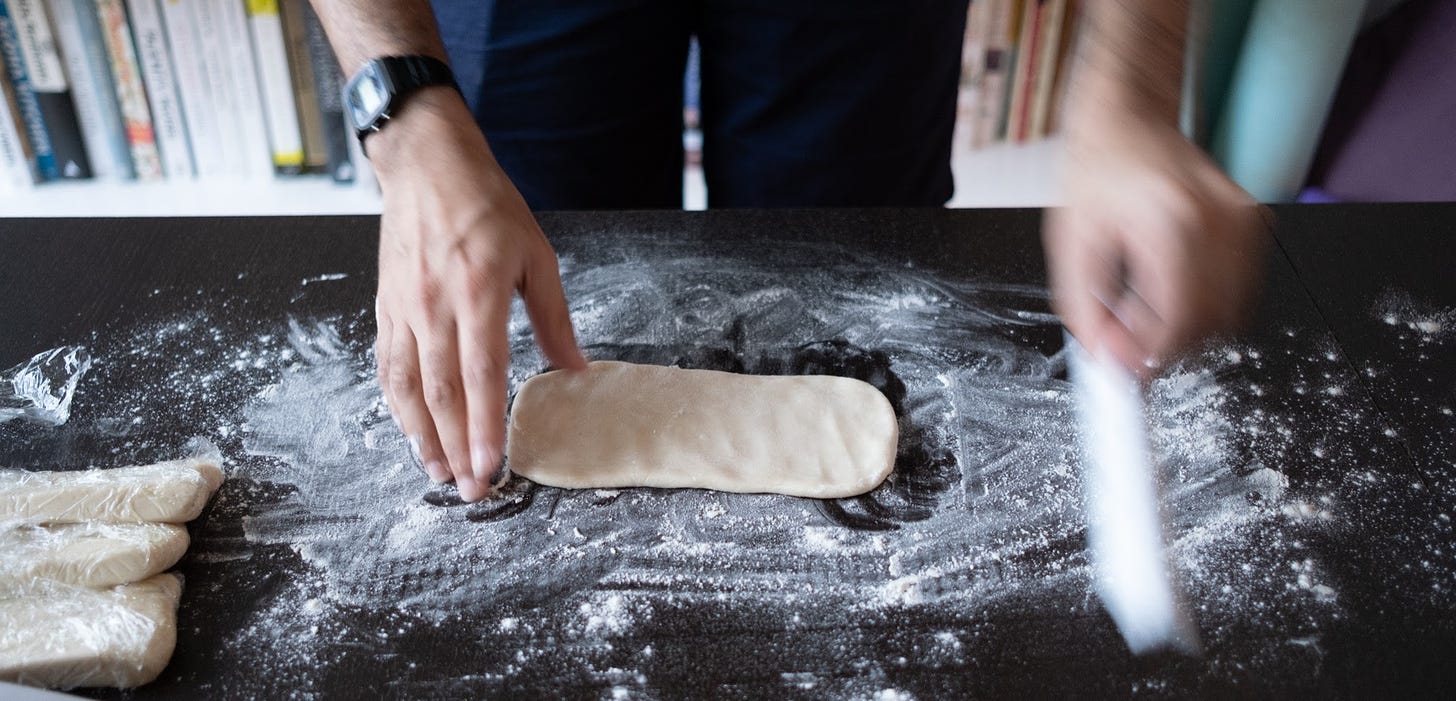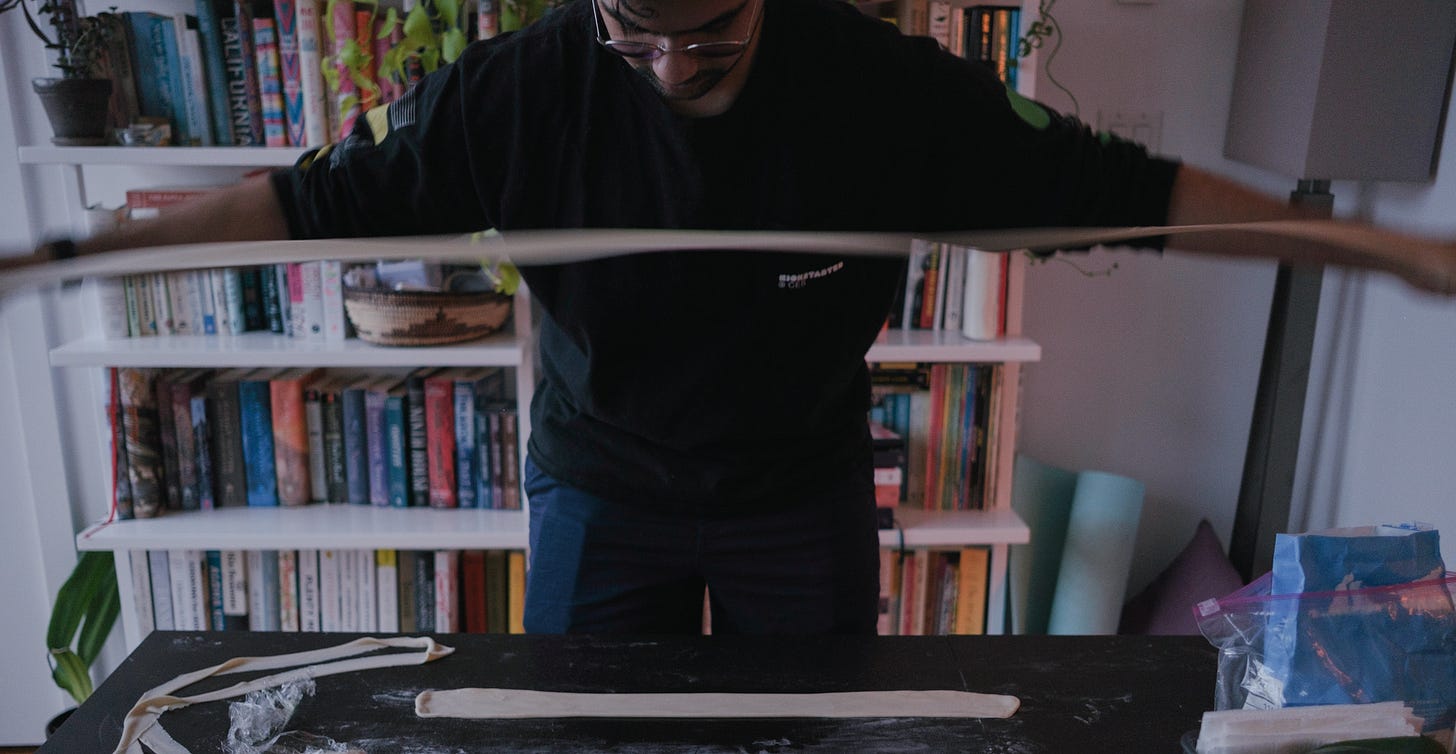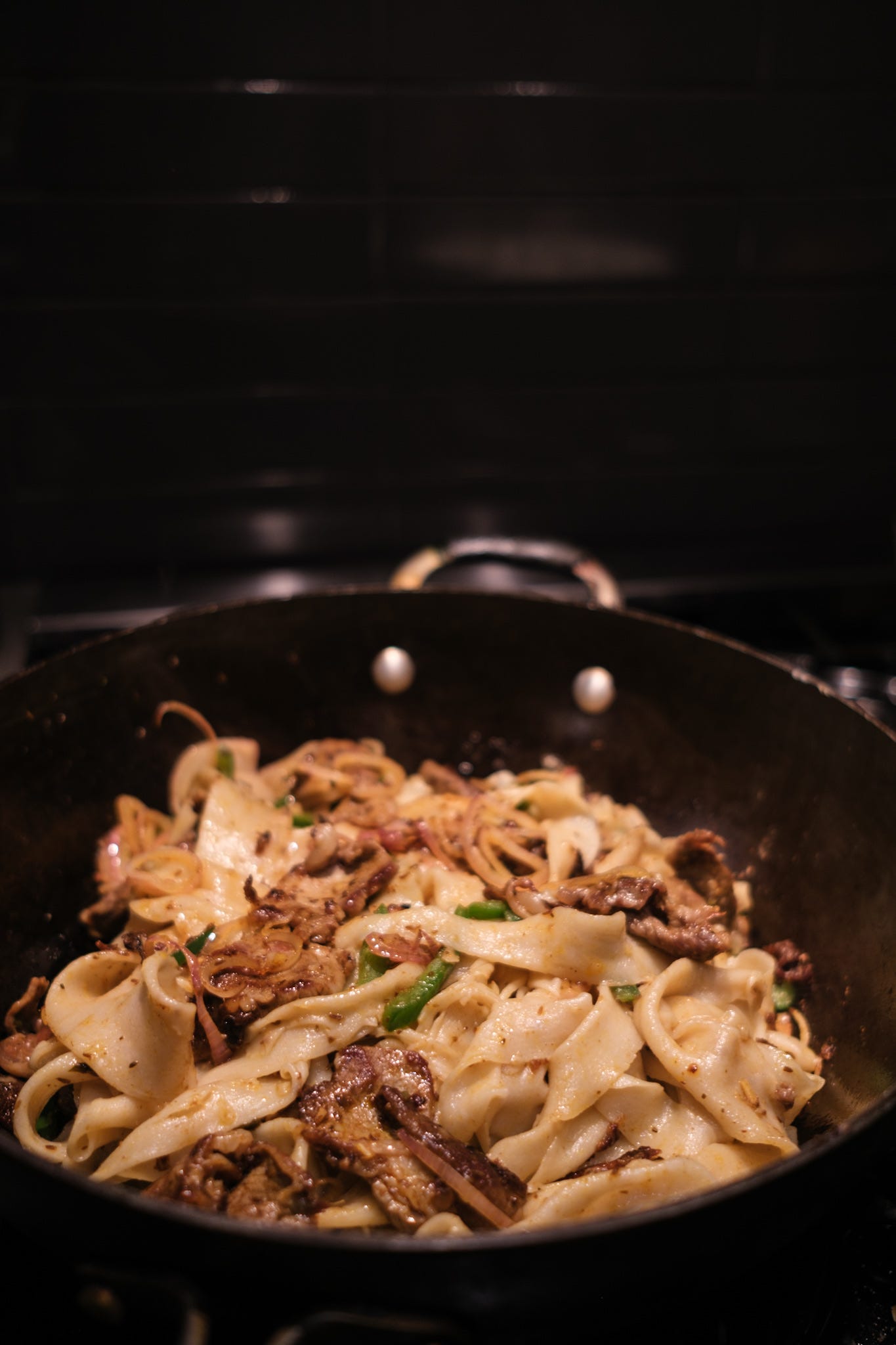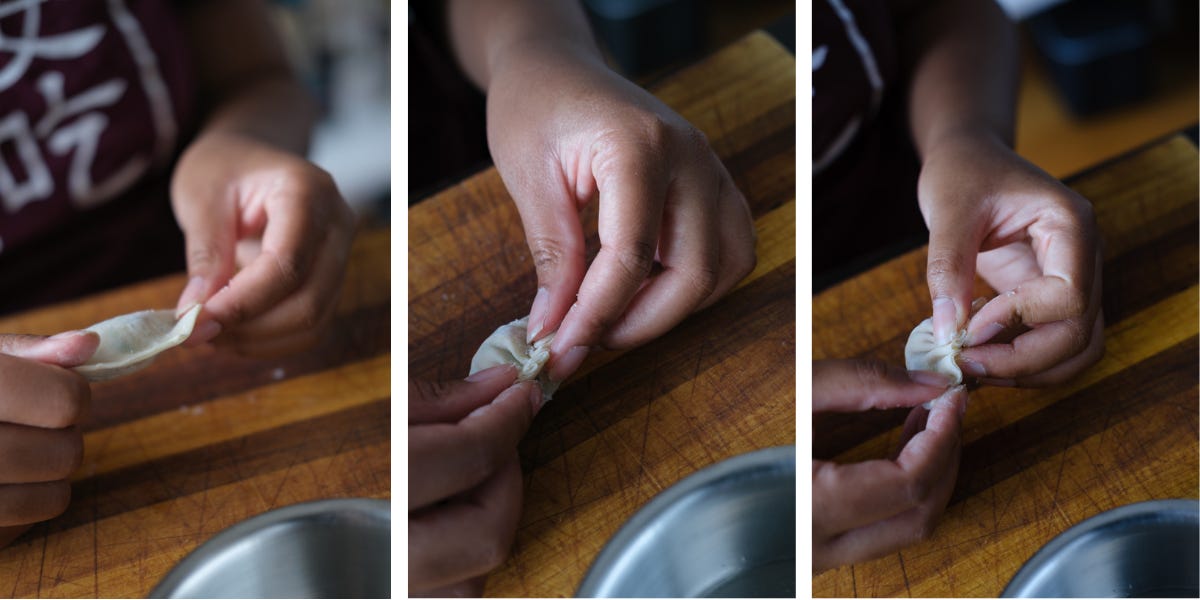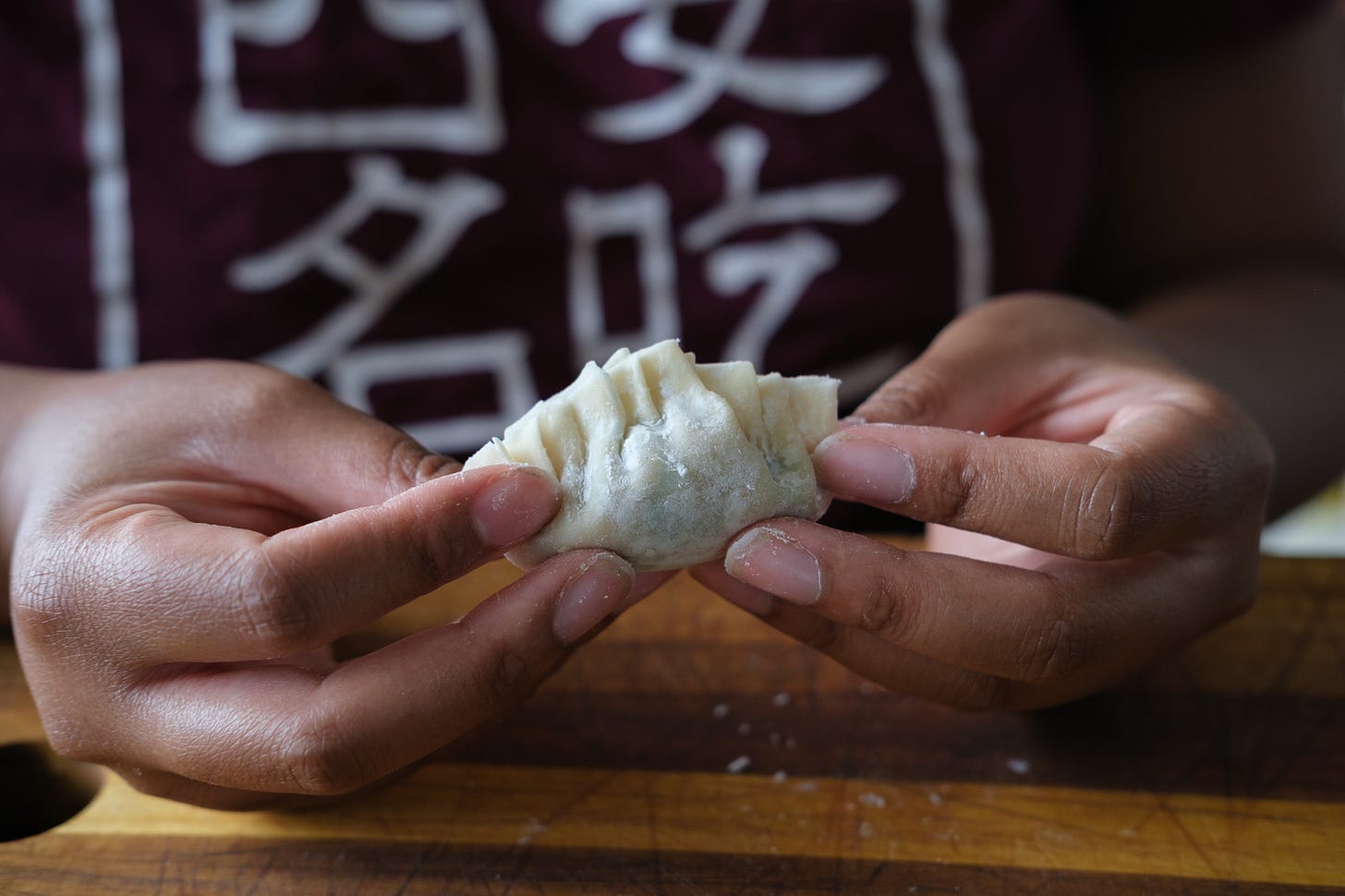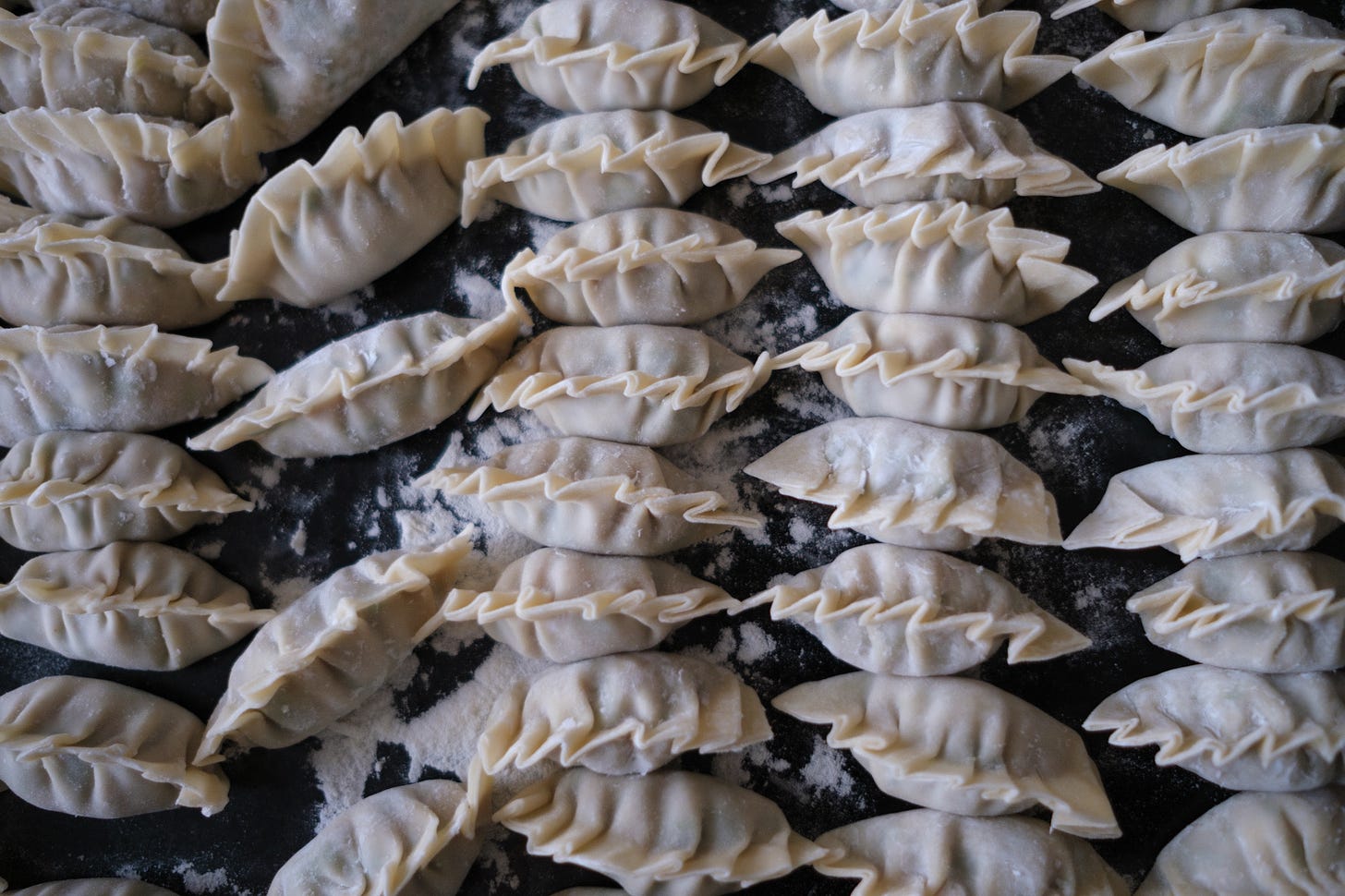Restaurant cookbooks are usually pretty annoying. They’re infamously not cookable, even the ones that promise they will be. Dishes made in restaurants are composed with totally different logic, where specialty ingredients can be easily acquired in bulk; it’s normal to make a lot of something at a time (I’ll never forget David Chang casually telling the reader to just freeze leftovers of the 100 steamed buns his Momofuku Cookbook recipe makes because they couldn’t reduce it down to a smaller proportion than that); and extensive mis en place (cutting up all the ingredients) isn’t an annoyance because the person doing it might not be the person actually composing the final dish. So yeah, I don’t really buy restaurant cookbooks.
But the more I read for this newsletter, the more I find that what makes a great cookbook isn’t always the cookability of the recipes but the story the book is using the recipes to tell. Xi’an Famous Foods: The Cuisine of Western China, from New York's Favorite Noodle Shop manages to make the famous New York noodle restaurant’s recipes accessible while spinning quite a tale. Xi’an Famous Foods co-owner Jason Wang and his co-writer Jessica K. Chou use a progression of recipes to tell the story of how Wang and his family found a home in the United States after immigrating here from Xi’an, the capital of the Shaanxi province in central China. Throughout the book, they peel back the layers of culinary influence that shaped the restaurant, and shaped Wang’s immigrant experience. Most poignantly, the book highlights the role of New York City’s Chinatowns (yes, there’s more than one) in supporting the Asian diaspora while also recognizing diasporic life as fundamentally separate from what might now be considered “authentic” where one came from.
You can’t get to know these recipes without getting to know Wang and his family. Each chapter represents a period in Wang’s life: childhood in Xi’an; moving to suburban Michigan; adolescence in Connecticut and Queens; opening and expanding Xi’an Famous Foods during and after Wang’s college years; and the adult life he built around the restaurant. To start this journey, you are exposed to foundational flavors, ingredients, and recipes of Xi’an like flatbread, three kinds of noodles, and the sauces and chile oil served at the restaurant. You’ll then explore the recipes the Wang family created to make do with the scant Chinese ingredients they could find in Michigan like doctored up ramen, hong shao “red braised” spare ribs, and pineapple chicken; before moving to Connecticut put them in driving distance of Flushing, Queens, NYC’s biggest Chinatown. Able to stock up on good soy sauce, black vinegar, and the right cuts of meat, they could finally get closer to the dishes they knew in Xi’an. In comparison to the all-white neighborhood where he lived in Connecticut, Wang explains,
“Flushing was a reminder that there were other people out there like me...When I walked the streets, I blended in. I was normal. The neighborhood was also a promise that certain aspects of my life would gradually become accepted, that I wouldn’t always be made fun of for being different. It was an oasis, a sense of belonging.”
Jason Wang is here to keep it real. Though his story hits on some of the tropes of immigrant life in the U.S.—not getting the cultural references or expectations of your white peers at school; parents hustling in low-wage jobs to ensure you had the opportunity to attend a good college and land a cozy corporate job—the happy ending isn’t assimilation and white collar success. Instead it’s carving out a space for the foods his family remembers from Xi’an in their new home; having the cash to buy an Aston Martin but still getting spit on by customers in the restaurant. Through the back-breaking work of growing Xi’an Famous Foods’ footprint, he built the opportunity for aspects of his life to become accepted, from the ground up.
Not that approval from whiteness didn’t play a role. The restaurant went from a hole in the wall outside Flushing’s Golden Shopping Mall where his dad, David Shi, decided to make some money selling bubble tea and delicate liang pi noodles to a destination people came from out of state to visit for the Xi’an specialties that were difficult to find anywhere else. Eventually Anthony Bourdain showed up, and after the restaurant appeared on an episode of No Reservations, as Wang tells it, “we aren’t just catering to Flushing locals anymore, or even just the Chinese community; we’re representing our food to people everywhere.” After graduating college and getting fired from aforementioned cozy corporate job, Wang joins his dad at the restaurant full time and helps him expand it from Flushing to Chinatown to the East Village and eventually 14 total locations across the city (now dwindled to eight due to closures in the pandemic).
By the time we got this book, my partner had already eaten at the Xi’an Famous Foods location near his office in North Brooklyn several times and wanted to try making the Biang-Biang Noodles. These thick, chewy noodles are hand ripped to order and Wang insists they have to be cooked immediately after being made. We watched just about every video we could find where Wang and his dad demonstrated them, though the book has straightforward, easy to follow instructions and illustrations to help you. My partner (who you might recall is the master of dough in our household) found them pretty easy to make if you are up for following the process, with precise timings to knead and repeatedly rest the dough before stretching it as far as your arms can spread by banging strips of dough on a counter repeatedly and pulling it apart into wide strands.
The first time we had the noodles, we made the Hot Oil Seared version, topped with the closest thing to the recipe we had on hand (scallions, no chives or celery, and substituting Belgian endive for cabbage) along with the requisite XFF Noodle Sauce of soy sauce, black vinegar, and spices; XFF chili oil; chili powder; and shimmering hot oil. Rather than attempting to recreate the XFF chili oil through the recipe in the book, I ordered it to be shipped straight from the restaurant and recommend you do the same (even if you don’t buy the book!). You’re not going to recreate the heady aroma or perfect balance of this ruby red, syrupy oil at home, given that the real version uses over 30 spices. Altogether, the dish was delicious, and even with the uncalled for bitterness of the endive, the flavors of the toppings melded together beautifully in layers of spicy, tangy, oniony perfection.
Later, we were ready to make the signature dish Spicy Cumin Lamb over biang-biang noodles, involving a trip to my local bougie butcher for thinly sliced boneless lamb leg where I was told I was far from the first to request exactly this cut to make exactly this dish. What can I say, I’m a type. The lamb comes together quickly and has rich flavor from the cumin, which looks like a lot (1 ½ tablespoons for less than a pound of meat) but mellows out in the pan and provides an earthy base for the pop of nearly raw red onion and hot chiles. I toned down the heat level by reducing the amount of chile powder and using a seeded jalapeno instead of a sliced hot longhorn pepper because my tolerance isn’t that high, but honestly I regret it and recognize that the interplay of warm spice and heat would have been better if I hadn’t chickened out.
Our last recipe test was the Pork and Chives dumplings. The pork mixture is easy to make but you’ll need to commit to a few specialty ingredients like oyster sauce (fairly available at grocery stores) and Shaoxing wine (much less so). My favorite part was the finely chopped water chestnuts in the mixture, filling the space usually held by cabbage—they add really nice pops of crunch to the dumplings. Fried as potstickers and served with the XFF Dumpling Sauce (like the noodle sauce, but with ratios of soy sauce and black vinegar flipped) and chili oil they’re now my favorite at home dumplings—and this is not my first rodeo. Friends joined us over Zoom to make the vegetarian spinach dumplings and shared that the sauces are essential to round out the flavor.
I do have to caution, these do still come with the challenges of restaurant recipes. Orchestrating the lamb and noodles together in a New York apartment was a bit of an ordeal, where the noodles had to be pulled on the dining table in another room then rushed into the kitchen at just the right time to boil when the lamb was almost done. The dumplings necessitated a trip to Sunset Park (where Brooklyn’s Chinatown can be found) to get ingredients like Chinese chives and Shaoxing wine. But really, if you’re going to get a cookbook that teaches you another cuisine, chances are you will need to hunt down some new ingredients. And the work is worth it--the lamb noodles were an at-home date night highlight and we made over 50 dumplings at once, stashing them in the freezer for meals to come.
And I have to emphasize, as the book does, that this is not the end-all be-all of Shaanxi cuisine. This is, clearly and deeply, one family’s story and one restaurant’s interpretation of beloved foodways. Wang’s father composed the menu from traditional preparations and his own ideas and inspirations, as any chef would. In the Spicy Cumin Lamb recipe note, Wang explains,
“I’d say we put lamb noodles and lamb burgers on the culinary map. While cumin lamb is commonly found in many parts of northern and western China, this dish is rarely served with biang-biang noodles or in a bun in Xi’an. So if someone is serving lamb noodles or burgers without shouting out XFF, you know who they were inspired by.”
And just like the Wang family has evolved the cuisine from their restaurants in New York, it’s changing in China, too. Wang’s reflection on a trip to Xi’an as an adult is telling:
“I had this image of China, frozen in time for seventeen years, but I’ve come to terms with the fact that the Xi’an I knew is gone. Every trip back, I see a new, more efficient, automated way to make liang pi, another Instagram-friendly shop, another fusion version of a traditional dish. Things are changing, so quickly.”
Over the course of the book, Wang charts an incredible journey from carefully stockpiling Chinese ingredients in trips to Flushing, to launching a restaurant empire there that made the city pay attention to his region’s cuisine. His return to Xi’an exposes the fact that what you and your community become in a new place will never be a carbon copy of where you came from, and that your place of origin keeps living, breathing, and changing as you do. Through the Xi’an Famous Foods cookbook, we get a taste of what it means to create the space where you belong.
A note of Black-Asian solidarity:
The ongoing increase in anti-Asian violence in the U.S. I’m sure has been difficult beyond words to witness and absorb. From years of having to process police killings of Black people in the news (not to mention the many other impacts of systemic racism), I unfortunately understand the deep sadness, rage, and fear, that comes with this. For me personally, the barrage of news about this kind of violence--not only in traditional media but all over my social feeds--is its own kind of oppressive, even when the messages are well-meaning statements of solidarity.
What I want to offer is this: the knowledge I hold that to be a person of color in America is more than being a victim of white supremacy. I am proud of the beautiful culture of my community and the impact Black music, dance, and revolutionary thought have had on my life. In this overwhelmingly traumatic time, I hope that you can grasp onto a thread of whatever joys your own community has brought you, too, and remember that you are more than anything and everything whiteness could expect of or impose on you.
Resources and Reading
I gave a portion of my stimulus check last month to Welcome to Chinatown, a nonprofit that provides support to keep Manhattan’s Chinatown on its feet and elevate Asian American voices. Also their swag is dope, as you can see from my shirt in these photos.
The article “The Limits of the Lunchbox Moment” digs deeper into the nuances of immigrant experiences around food beyond common tropes.
Xi’an Famous Foods has struggled during the pandemic and its staff have faced anti-Asian violence personally. Read more about that here.
If you want to support the restaurant, you can buy the book, chili oil, swag, and meal kits that ship nationwide on their website. (I’m wearing their t-shirt in the dumpling photos.)
Next issue: I’ll be attempting to unpack the issues with a white expert covering a non-white cuisine with a review of The Gaijin Cookbook: Japanese Recipes from a Chef, Father, Eater, and Lifelong Outsider by Ivan Orkin and Chris Ying.




